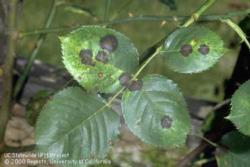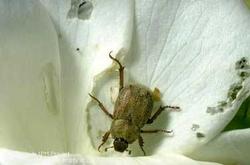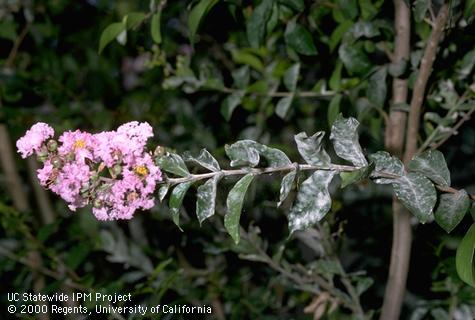
May
Rose Problems
Black Spot
Q. I have black spots on the leaves of my roses and the leaves are turning yellow and dropping off. What are the spots? How can I get rid of them?

Pest Note: Black Spot
Thrips
Q. The flowers on my rose shrubs are not opening. They have brown spots and streaks on them. What is causing this?
A. Flower thrips are more than likely the problem. Check for their presence by shaking a rose bud over a white piece of paper. Thrips are tiny (less than 1/2 inch), long-bodied, greenish-black bugs. They live inside the buds of many garden plants and their feeding habits cause damage to the petal tissue which then turns brown and fails to open. They are difficult to control because they constantly move from plant to plant in the garden. Remove and destroy all infected buds and blooms. You can also try spraying with an insecticidal soap or pyrethrin-based spray-making sure to follow directions carefully.
The bad news is that sprays don't penetrate inside the buds. The other bad news is that systemic insecticides often contain an organophosphate such as disulftoton (Di-Syston) which is very toxic to humans. Use of oranophosphates in the garden is now being discouraged. The good news is that the thrip population is most active in spring and later bloom cycles should suffer less damage.
Pest Note: Thrips
Beetles
Q. There are holes in the flowers on my roses (especially the light-colored roses) and on some of the leaves. What is the from?

Pest Note: Hoplia Beetle
Powdery Mildew
Q. The new growth on my roses is covered with a grayish-white powder and the leaves are puckering. Is this a disease? If so, what can I do?

Good cultural practices can help prevent infestation. Plant resistant varieties in sunny spots, prune to provide good air circulation and keep the garden cleaned up. At the first sign of problems, try to wash off as much of the powdery mildew as possible. Do not overfertilze-powdery mildew loves tender, new growth. Fungicide sprays containig sulfur or triforine can be used. Timing of application is important. Respray at 7-10 day intervals if mildew reappears.
Pest Note: Powdery Mildew
